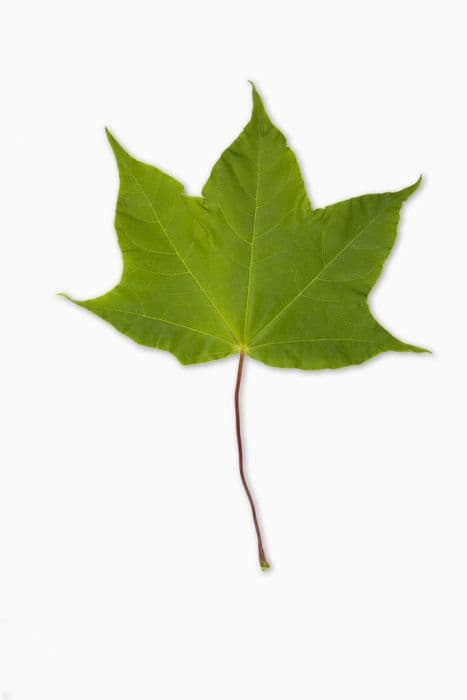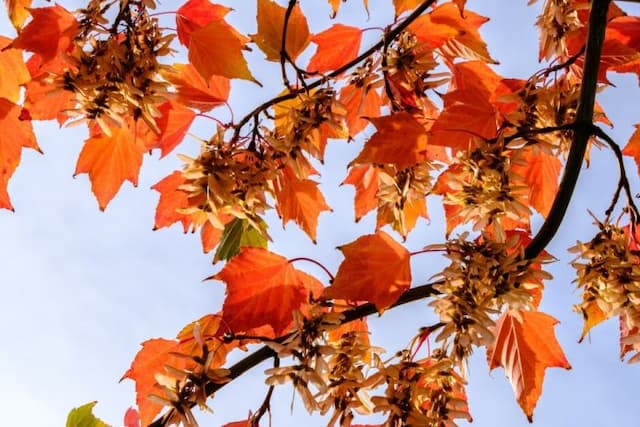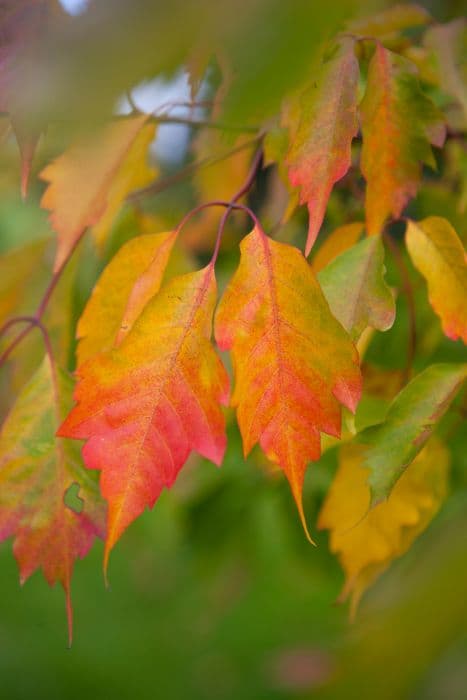Japanese Maple Acer palmatum 'Shojo-shidare' (D)

ABOUT
The Japanese maple 'Shojo-shidare' is a particularly striking variety featuring cascading branches and foliage that can make a dramatic statement in any garden. This cultivar is known for its distinctive leaf shape and seasonal color changes. The leaves are deeply dissected and lace-like, which gives them an almost feathery appearance. In spring, the new foliage emerges a bright and vivid red, providing a burst of color that catches the eye. As the seasons progress, the leaves transform, going through various shades of red, often with undertones of purple, before eventually turning to fiery tones in the fall. The 'Shojo-shidare' carries its leaves in a way that creates a weeping effect, making the branches bend gracefully toward the ground. This weeping form adds an element of elegance and can become a central feature in a landscape design. Additionally, the tree's bark is typically smooth with an attractive, slightly grayish tone that provides winter interest when the leaves have fallen. Overall, the Japanese maple 'Shojo-shidare' is prized for its ornamental value, with its striking leaf color and delicate, weeping structure, making it a beloved choice for adding drama and beauty to garden settings.
About this plant
 Names
NamesFamily
Sapindaceae
Synonyms
Japanese Maple, Red Select Laceleaf Japanese Maple, Weeping Japanese Maple, Shojo-shidare Maple
Common names
Acer palmatum 'Shojo-shidare'
 Toxicity
ToxicityTo humans
The Japanese maple is typically not considered toxic to humans. However, ingestion is not recommended as it is not a food plant, and there may still be individual cases of allergic reaction or gastrointestinal discomfort if parts of the plant are swallowed.
To pets
The Japanese maple is generally considered non-toxic to dogs, cats, and horses. There should not be any significant risk of poisoning if pets consume parts of this plant. However, as with any non-food plant, ingestion of large quantities may cause mild stomach upset in some pets.
 Characteristics
CharacteristicsLife cycle
Perennials
Foliage type
Deciduous
Color of leaves
Red
Height
6-8 feet (1.8-2.4 meters)
Spread
6-8 feet (1.8-2.4 meters)
Plant type
Tree
Hardiness zones
5-8
Native area
Japan
Benefits
 General Benefits
General Benefits- Ornamental Appeal: 'Shojo-shidare' Japanese Maple is highly prized for its cascading habit and beautiful, deeply lobed, reddish-purple leaves that add aesthetic appeal to any garden.
- Seasonal Interest: This cultivar provides year-round visual interest with leaves that change color throughout the seasons—from vibrant spring greens to rich autumnal reds and purples.
- Shade Providing: Its canopy offers shade in garden spaces during the hot summer months.
- Size: Its compact size makes it ideal for small gardens or growing in containers.
- Low Maintenance: Japanese Maples, in general, require minimal pruning and are relatively low-maintenance once established.
- Cultural Significance: The tree carries cultural significance in Japan, making it a wonderful choice for Asian-themed gardens or for those wanting to create a sense of Zen in their landscaping.
- Wildlife Attraction: While not known specifically for its wildlife benefits, it can provide shelter for birds and insects among its branches.
- Versatility in Landscape Design: The 'Shojo-shidare' is versatile in landscape design, suitable as a focal point, for softening building lines, or for incorporating into mixed beds.
 Medical Properties
Medical PropertiesThis plant is not used for medical purposes.
 Air-purifying Qualities
Air-purifying QualitiesThis plant is not specifically known for air purifying qualities.
 Other Uses
Other Uses- Photographic Subjects: Japanese maple's unique structure and colorful foliage make it a fantastic subject for photographers, especially in autumn.
- Bonsai Specimens: Due to their elegant form, Japanese maples are often used in the art of bonsai, providing a stunning miniature landscape.
- Wedding Decor: Branches of Japanese maple are sometimes used in floral arrangements and decorations at weddings for their delicate leaves and vibrant colors.
- Aquarium Landscaping: The wood of the Japanese maple, when treated properly, can be used in aquariums to create naturalistic habitats for fish.
- Artistic Inspiration: Artists might use the leaves or the shape of the Japanese maple as inspiration for paintings, textiles, or other forms of art.
- Feng Shui: Japanese maples are sometimes planted in gardens adhering to Feng Shui principles to enhance the energy flow and provide beauty.
- Culinary Presentation: Leaves can be used as a natural garnish or a decorative element for plating dishes in high-end culinary presentations.
- Literary Symbol: The Japanese maple can serve as a symbol in literature and poetry, representing beauty, change, or the ephemeral nature of life.
- Cultural Festivals: Used in displays and decorations during Japanese cultural festivals, such as autumn viewing festivals (momijigari).
- Fashion Design: The distinctive leaf shape has been used as a motif or inspiration in clothing and accessory designs.
Interesting Facts
 Feng Shui
Feng ShuiThe Japanese Maple is not used in Feng Shui practice.
 Zodiac Sign Compitability
Zodiac Sign CompitabilityThe Japanese Maple is not used in astrology practice.
 Plant Symbolism
Plant Symbolism- Beauty: The 'Shojo-shidare' is a variety of Japanese Maple known for its elegant and cascading branches, embodying natural beauty and grace.
- Endurance: Despite its delicate appearance, Japanese Maples are resilient and can endure through harsh conditions, symbolizing strength and perseverance.
- Change and Transformation: With leaves that change color through the seasons, the Japanese Maple represents the ever-changing nature of life and the ability to adapt.
- Blood and Passion: The 'Shojo-shidare' often has deep red leaves, which can symbolize both blood, representing vitality and life, as well as deep passion.
- Peace and Calm: The serene appearance of the Japanese Maple can bring peace to a garden space, symbolizing tranquility and calmness.
- Balance: The balanced, symmetrical growth habit of the Japanese Maple serves as a physical representation of harmony and equilibrium in life.
 Water
WaterThe Japanese Maple requires even moisture and should be watered once or twice a week, depending on soil drying conditions. During hot, dry periods, increase the frequency to twice a week. The goal is to maintain moist but not soggy soil. When watering, use a soaker hose or drip system to apply water directly to the soil, providing about 1 to 1.5 gallons of water per week. Avoid overhead watering to prevent leaf scorch and fungal diseases.
 Light
LightJapanese Maples thrive in a spot that offers partial shade, typically receiving morning sun and afternoon shade or dappled sunlight throughout the day. This light condition helps protect the delicate leaves from harsh midday sun that can cause leaf burn. An eastern exposure is often ideal, protecting the tree from the intense late-day sun.
 Temperature
TemperatureJapanese Maples prefer a temperate climate and do best when temperatures hover between 60 and 80 degrees Fahrenheit; however, they can withstand brief periods of temperatures as low as -20 degrees and as high as 90 degrees Fahrenheit. Adequate mulching and watering can help regulate soil temperature and assist in extreme weather conditions.
 Pruning
PruningPrune the Japanese Maple to maintain its shape and encourage healthy growth. The best time to prune is in late winter to early spring before the sap starts flowing. Pruning can be done annually, removing dead or crossing branches to enhance the tree's structure and increase air circulation.
 Cleaning
CleaningAs needed
 Soil
SoilJapanese Maple prefers well-draining, acidic to neutral soil mix with pH between 5.5 and 6.5. A mixture of loamy soil, peat moss, and perlite or pine bark will ensure proper drainage and aeration.
 Repotting
RepottingJapanese Maples should be repotted every 2-3 years in early spring before new growth begins to prevent root-bound conditions and replenish nutrients in the soil.
 Humidity & Misting
Humidity & MistingJapanese Maple thrives best in average humidity levels but is adaptable to various humidity conditions provided it's not consistently too wet or too arid.
 Suitable locations
Suitable locationsIndoor
Place in bright, indirect light; keep away from heat sources.
Outdoor
Shelter from harsh winds; partial sun; well-draining soil.
Hardiness zone
5-8 USDA
 Life cycle
Life cycleAcer palmatum 'Shojo-shidare', commonly known as Japanese maple 'Shojo-shidare', begins its life cycle when a seed germinates in spring, given proper warmth and moisture. The seedling emerges and develops into a young sapling, producing characteristic lobed leaves that change through a spectrum of colors with the seasons. As the sapling matures, it undergoes a period of vegetative growth each year, forming a delicate, weeping habit with branches that cascade downward. During its reproductive phase, which may take several years to commence, the Japanese maple produces small, inconspicuous flowers followed by the development of winged samaras (seed pods) which disperse in the wind. It continues this cycle annually, entering a period of dormancy during winter when leaf drop occurs. This deciduous tree can live for many decades, slowly growing into its full size and shape, creating a distinctive feature in gardens and landscapes.
 Propogation
PropogationPropogation time
Early Spring
The most popular method for propagating the Japanese Maple 'Shojo-shidare' is through softwood cuttings. This technique is best undertaken in early summer when the new growth is firm enough but not yet fully hardened. A cutting, typically 4 to 6 inches (10 to 15 centimeters) long, is taken from a healthy branch with a sharp, clean pair of pruning shears. The leaves on the lower half of the cutting are removed, and the cut end is dipped into a rooting hormone powder to encourage root development. The prepared cutting is then inserted into a pot filled with a mixture of peat and perlite or a fine-grade vermiculite. The cutting should be placed in indirect light and kept consistently moist, with high humidity maintained around it, for several weeks until roots have formed and new growth is evident.









